Table of Contents
Plot
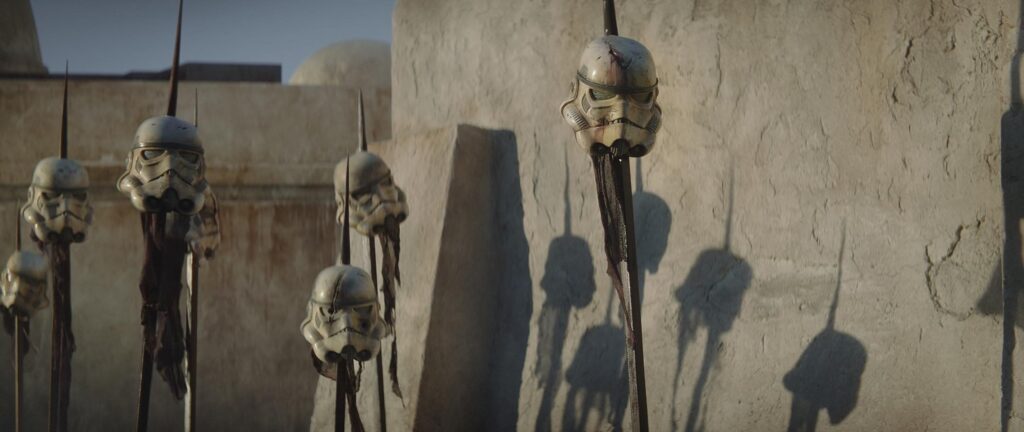
Welcome to The Mandalorian S1 E5 Review. The Mandalorian’s ship, the Razor Crest, is in need of repairs after sustaining damage in previous episodes. He decides to land on the desert planet Tatooine to seek refuge and repairs. Upon landing in the outskirts of the planet’s Dune Sea, the Mandalorian is greeted by a rookie bounty hunter named Toro Calican, who is seeking to join the Bounty Hunter’s Guild.
Toro offers to help the Mandalorian with his ship repairs in exchange for partnering with him on a bounty hunting job. The Mandalorian initially declines but eventually agrees to help, with the goal of earning enough credits to repair his ship.
The target is Fennec Shand, a notorious assassin and fugitive with a high bounty on her head. The Mandalorian and Toro set out to track down Fennec, leading to a tense confrontation in the desert. Fennec proves to be a formidable opponent, and the Mandalorian and Toro are forced to take cover and strategize.
During their stand-off, Toro reveals his true intentions: he wants to capture Fennec and claim the bounty himself to earn Guild membership and a reputation. However, Fennec tries to convince the Mandalorian to team up with her, offering a better deal.
In a clever maneuver, the Mandalorian and Toro outwit Fennec by having Toro distract her while the Mandalorian circles around to incapacitate her. With Fennec captured, Toro decides to betray the Mandalorian and take both bounties for himself. A showdown ensues, resulting in Toro’s demise at the hands of Fennec.
The Mandalorian decides to return to Mos Eisley, where he left Baby Yoda with mechanic Peli Motto. He retrieves Baby Yoda and sets off to continue his journey across the galaxy.
The episode explores the theme of trust and partnerships in the bounty hunting world. The Mandalorian’s cautious approach contrasts with Toro’s eagerness to prove himself, illustrating the complexities of alliances formed for personal gain.
The choices made by the characters lead to consequences. Toro’s greed and betrayal result in his downfall, highlighting the risks associated with selfish motives.
The Mandalorian’s resourcefulness and strategic thinking are showcased as he navigates through challenges and adapts to unexpected situations, such as outsmarting Fennec.
The episode emphasizes the Mandalorian’s ongoing journey as he faces new challenges, expands his connections, and grapples with the responsibilities of protecting Baby Yoda.
In summary, episode 5 of “The Mandalorian” delves into the dynamics of the bounty hunting world while showcasing the Mandalorian’s resourcefulness and the consequences of character choices. The episode’s narrative intertwines action, strategy, and character development as the Mandalorian continues his journey across the galaxy.
Character development
The Mandalorian (Din Djarin):
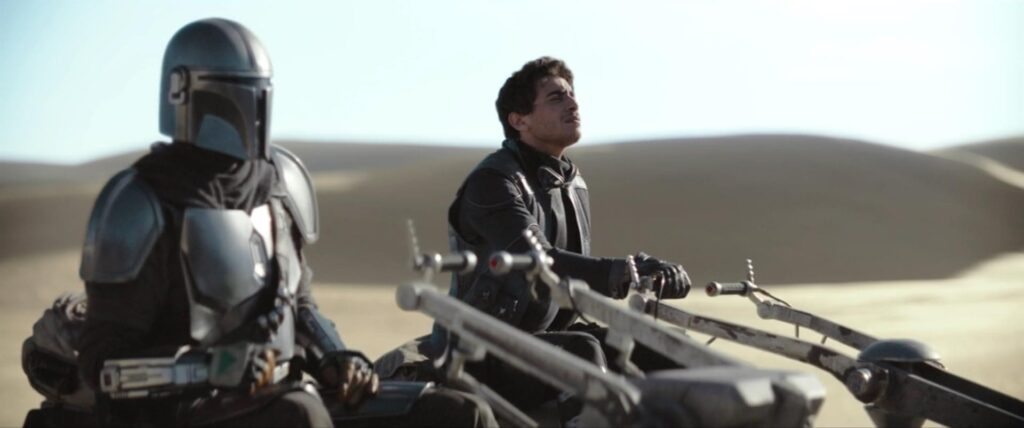
1. Trust and Skepticism: The Mandalorian’s character remains consistent with his cautious and skeptical nature. His initial reluctance to partner with Toro Calican showcases his reluctance to trust others in the bounty hunting profession.
2. Moral Code: Despite his tough exterior, the Mandalorian demonstrates his adherence to a moral code. His decision to spare the pit droids repairing his ship indicates his compassion and respect for life, even in the context of mechanical beings.
3. Protective Instinct: The Mandalorian’s strong protective instinct is evident in his interactions with Baby Yoda. He prioritizes the child’s safety and well-being, highlighting his evolving attachment to his young charge.
4. Resourcefulness and Strategy: Throughout the episode, the Mandalorian’s resourcefulness and strategic thinking are on display. His ability to navigate challenging situations and adapt to unexpected developments underscores his competence as a seasoned bounty hunter.
Toro Calican:
1. Desire for Reputation: Toro Calican’s character is driven by a desire for reputation and recognition within the Bounty Hunter’s Guild. He seeks to earn his place by capturing a high-profile fugitive like Fennec Shand.
2. Naïveté and Eagerness: Toro’s inexperience as a bounty hunter becomes evident in his interactions with the Mandalorian. His eagerness to prove himself often leads to impulsive decisions, highlighting his naivety in the dangerous profession.
3. Ambition and Betrayal: Toro’s ambition drives him to betray the Mandalorian in his pursuit of personal gain. His willingness to manipulate and deceive underscores his desperation to establish himself in the bounty hunting world.
4. Consequences of Choices: Toro’s character development serves as a cautionary tale about the consequences of choices driven by self-interest. His actions lead to his own demise, illustrating the risks of prioritizing personal gain over ethical considerations.
Baby Yoda:
1. Continued Bond: Baby Yoda’s presence remains a consistent source of attachment and connection for the Mandalorian. Although not the central focus of this episode, their bond is reaffirmed when the Mandalorian retrieves Baby Yoda from Peli Motto.
In summary, episode 5 of “The Mandalorian” advances character development through the interactions and choices of the Mandalorian, Toro Calican, and the ongoing relationship between the Mandalorian and Baby Yoda. The episode further explores themes of trust, ambition, and the complexities of the bounty hunting profession while deepening our understanding of the main characters’ personalities and motivations.
Visual effects and cinematography
Visual Effects:
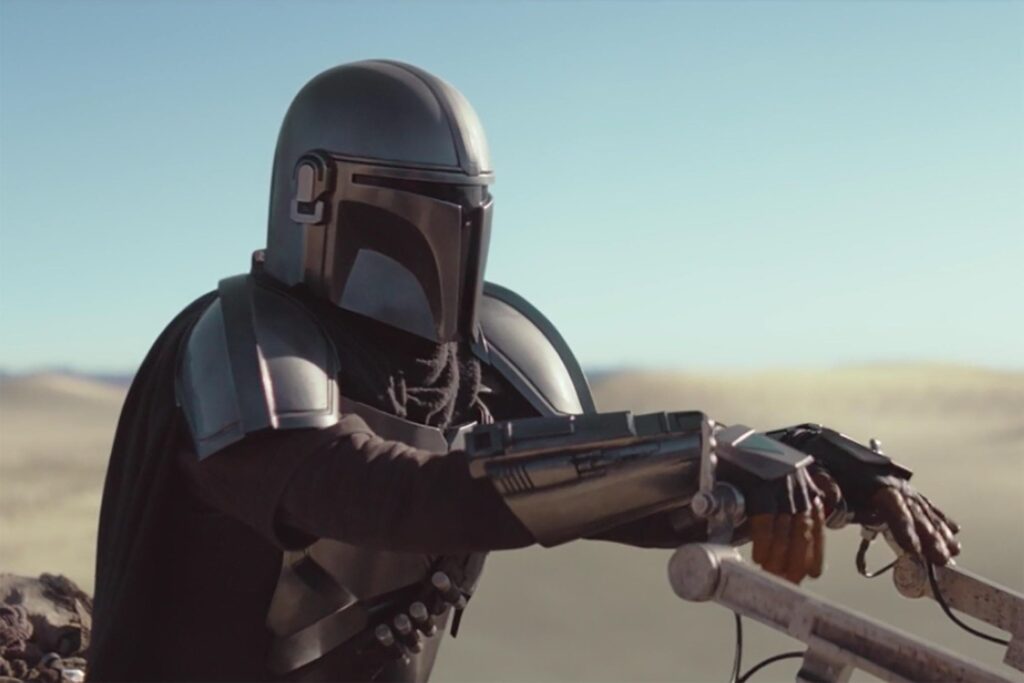
1. Ship and Planet Transitions: The episode showcases impressive visual effects during the transitions between space travel and planetary atmospheres. The depiction of the Razor Crest entering Tatooine’s orbit is seamless and immersive.
2. Landscape and Environments: The visuals capture the harsh and iconic landscapes of Tatooine, including the barren desert and rocky terrain. The use of CGI enhances the authenticity of the environment, creating a familiar and immersive setting.
3. Starship Sequences: The sequences involving starships, such as the Razor Crest and speeder bikes, demonstrate the attention to detail in their design and movement. Visual effects contribute to the believability of these vehicles within the “Star Wars” universe.
4. Droids and Droid Repair: The pit droids repairing the Razor Crest showcase the seamless integration of practical effects and CGI. Their movements and interactions with the ship blend seamlessly into the scenes.
Cinematography:
1. Iconic Shots: The episode features classic “Star Wars” visual motifs, including wide shots of Tatooine’s desert landscape, capturing the planet’s vastness and isolation.
2. Lighting and Atmosphere: Cinematography plays a crucial role in conveying the harshness of Tatooine’s environment. The play of light and shadow on characters and surroundings adds to the atmosphere, particularly during the desert showdowns.
3. Action Sequences: The cinematography captures the intensity of action sequences, including the standoff with Fennec Shand. The camera angles and movement contribute to the suspense and excitement of these moments.
4. Character Interactions: Close-ups and framing during character interactions emphasize the emotional weight of their conversations. The cinematography highlights facial expressions and nonverbal cues, enhancing character dynamics.
5. Emphasis on Detail: Cinematography draws attention to small details, such as the Mandalorian’s helmet reflections and the mechanics of the pit droids, enhancing the overall visual experience.
6. Visual Storytelling: The cinematography effectively tells the story visually, conveying information without relying solely on dialogue. The choice of shots and compositions aids in conveying character motives and narrative progression.
In summary, episode 5 of “The Mandalorian” utilizes impressive visual effects and cinematography to immerse viewers in the “Star Wars” universe. The seamless integration of CGI with practical elements, attention to detail in design, and evocative camera work all contribute to the visual richness of the episode. The cinematography not only captures the iconic aesthetics of Tatooine but also enhances character interactions and action sequences, enhancing the overall narrative experience.
World-building of the series
Tatooine Revisited:

1. Iconic Locations: The episode returns to the desert planet Tatooine, a planet rich in “Star Wars” history. Iconic locations such as Mos Eisley, known for its bustling cantina, and the Dune Sea are revisited, evoking nostalgia for fans of the franchise.
2. Harsh Environment: The world-building emphasizes the harshness of Tatooine’s environment, with its vast desert plains, rocky canyons, and twin suns. These visuals reinforce the planet’s reputation as a remote and unforgiving world.
New Elements:
1. Mos Eisley Spaceport: The episode introduces a new aspect of the famous Mos Eisley spaceport, showcasing docking bays, mechanical workshops, and the location’s seedy underbelly. This expansion adds depth to a familiar location.
2. Pit Droids: The pit droids repairing the Razor Crest provide insight into the mechanics and technology of the “Star Wars” universe. These droids add a layer of realism to the world-building by depicting everyday operations.
3. Toro Calican’s Background: The episode briefly mentions that Toro Calican hails from the Mid Rim, expanding the geographical scope of the galaxy and hinting at the varied cultures and backgrounds of its inhabitants.
4. Toro’s Motivations: As a rookie bounty hunter seeking Guild membership, Toro’s ambitions and backstory contribute to the understanding of the challenges and aspirations of individuals within the bounty hunting profession.
Galactic Continuity:
1. Established Lore: The episode maintains continuity with established “Star Wars” lore by depicting Tatooine’s recognizable landscapes, structures, and species. This consistency adds authenticity to the world-building.
2. Cross-Episode Connections: The return to Tatooine reinforces the sense of a connected universe by referencing events and characters from previous “Star Wars” films and episodes, enriching the storytelling experience.
Overall Expansion:
1. Depth and Texture: The world-building in this episode enriches the depth and texture of the “Star Wars” universe. It expands the audience’s understanding of Tatooine and introduces new elements that contribute to the planet’s lived-in feel.
2. Familiarity and Discovery: While maintaining the familiarity of Tatooine, the episode also introduces fresh perspectives, revealing new corners of the planet and demonstrating how the galaxy’s dynamics continue to evolve.
In summary, episode 5 of “The Mandalorian” contributes to world-building by revisiting the iconic planet Tatooine while introducing new locations, characters, and elements that expand the richness of the “Star Wars” universe. The episode balances the nostalgic appeal of familiar landscapes with the excitement of discovering new aspects of the galaxy far, far away.
The action sequences and direction
Action Sequences:
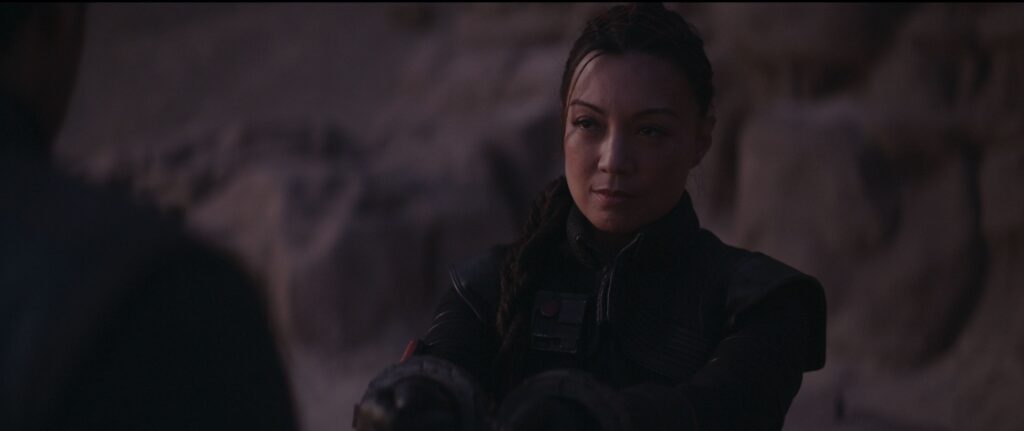
1. Desert Pursuit: The episode opens with a thrilling space chase between the Mandalorian’s Razor Crest and an unidentified ship. This pursuit adds an element of suspense and action, drawing viewers into the story.
2. Showdown in the Desert: The climactic showdown between the Mandalorian, Toro Calican, and Fennec Shand in the desert is a central action sequence. The dynamic movements, strategic positioning, and intense exchanges of gunfire create a sense of urgency and danger.
3. Toro’s Betrayal: The action sequence involving Toro’s betrayal is tense and unexpected. The sudden escalation of tension and the Mandalorian’s quick reflexes make for an intense moment that subverts expectations.
4. Mandalorian’s Strategy: The Mandalorian’s resourcefulness and strategic thinking are showcased during the stand-off with Fennec Shand. His use of cover, diversion tactics, and calculated movements demonstrate his expertise as a bounty hunter.
Direction:
1. Visual Storytelling: The director effectively uses visuals to convey character dynamics and relationships. Shots of the Mandalorian and Toro’s body language and expressions communicate their evolving partnership and underlying tensions.
2. Atmospheric Pacing: The episode’s pacing enhances the atmosphere, allowing tense moments to linger and build anticipation. This is particularly evident in the desert showdown, where the tension is palpable.
3. Character Motivations: The director skillfully portrays the motivations of the characters through their actions, expressions, and interactions. This adds depth to their personalities and creates a layered narrative.
4. Strategic Moments: The director captures the Mandalorian’s strategic approach during action sequences. By emphasizing his calculated decisions and tactical movements, the direction highlights his competence and expertise.
5. Mood and Tone: The direction maintains a consistent mood and tone throughout the episode, balancing action with character-driven moments and suspense. This cohesive approach contributes to the episode’s overall impact.
6. Cinematic Influences: The episode’s direction draws inspiration from classic Western films, incorporating framing, camera angles, and shots reminiscent of the genre. This choice enhances the episode’s distinct visual style.
Intensity and Suspense:
1. Building Tension: The director builds tension through pacing, framing, and sound design. The anticipation of conflicts and confrontations keeps viewers engaged and invested in the outcomes.
2. Strategic Movements: The direction effectively conveys the Mandalorian’s calculated movements and strategic thinking during action sequences. This adds an element of depth and complexity to the action.
In summary, episode 5 of “The Mandalorian” features well-choreographed action sequences and effective direction that heighten the episode’s suspense and excitement. The director’s emphasis on character dynamics, strategic movements, and atmospheric pacing contributes to the overall tension and engagement of the narrative.
Music and sound design
Music:

1. Themes and Motifs: The episode features the recurring musical themes established in previous episodes, such as the Mandalorian’s signature theme. These motifs anchor the narrative and characters, providing continuity and familiarity.
2. Tension and Suspense: The music effectively underscores moments of tension and suspense, heightening the emotional impact of action sequences and stand-offs. The use of rhythmic and percussive elements adds a sense of urgency.
3. Western Influence: As with previous episodes, the music continues to incorporate Western-inspired elements that reflect the show’s genre-blending approach. The fusion of Western motifs with “Star Wars” themes creates a unique musical identity for the series.
4. Character-driven Moments: The score complements character-driven moments, enhancing emotional scenes and interactions. The music adds depth to the characters’ motivations and internal struggles, enriching the storytelling.
Sound Design:
1. Desert Atmosphere: The sound design captures the harsh and isolated atmosphere of Tatooine’s desert landscapes. The winds, sand, and distant sounds of the desert contribute to the authenticity of the setting.
2. Starship Effects: The sound effects of starships and speeder bikes contribute to the realism of the “Star Wars” universe. The distinctive hum of engines and the Doppler effect during high-speed pursuits immerse viewers in the action.
3. Blaster Fire and Explosions: The sound design during action sequences emphasizes blaster fire and explosions, creating impactful audio cues that match the intensity of the visual effects.
4. Character Interactions: The sound design enhances character interactions by capturing subtleties in dialogue delivery, such as tone, emphasis, and emotional nuances. This attention to detail contributes to the authenticity of the performances.
5. Alien Creatures: The episode introduces the sounds of alien creatures, adding to the diversity and richness of Tatooine’s ecosystem. These sounds contribute to the immersion in the “Star Wars” universe.
6. Footsteps and Movement: The sound of footsteps, movement, and equipment contributes to the physicality of the characters and their actions. These details enhance the realism of the scenes.
Overall Immersion:
1. Cohesive Blend: The music and sound design work in tandem to create a cohesive audio experience. They complement each other to convey emotions, enhance action, and reinforce the visual storytelling.
2. Enhanced Atmosphere: The music and sound design collaborate to enrich the atmosphere of Tatooine, evoking the planet’s harshness, isolation, and sense of history within the “Star Wars” universe.
In summary, episode 5 of “The Mandalorian” continues to leverage music and sound design as essential components of the storytelling. The music’s thematic continuity, Western influences, and emotional resonance contribute to the episode’s narrative impact, while the sound design’s attention to detail and immersion-enhancing effects create an authentic auditory experience that complements the visual aspects of the series.
Pacing and structure
Pacing:
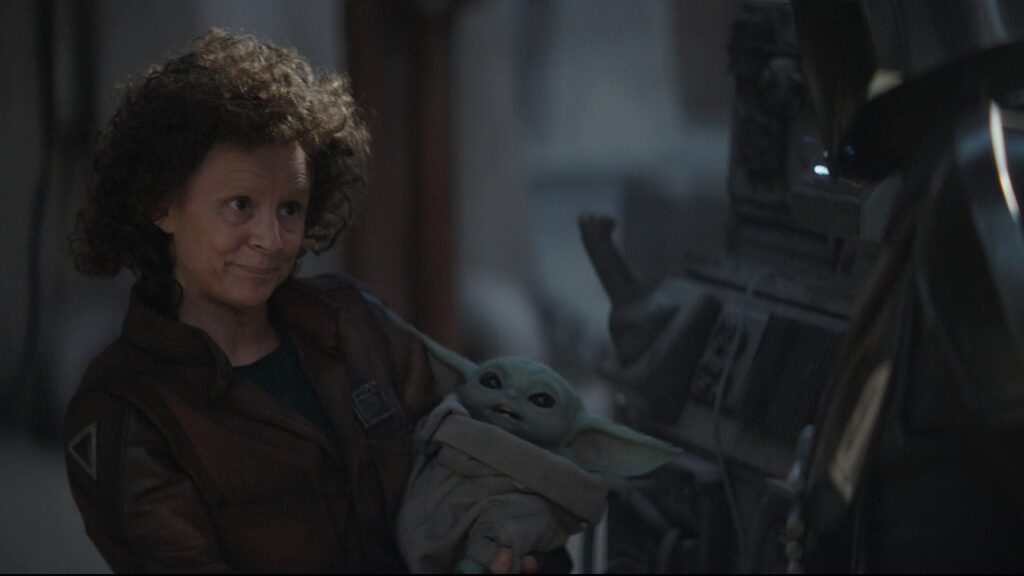
1. Engaging Opening: The episode opens with an intense space chase, immediately capturing viewers’ attention and setting a brisk pace. This opening sequence introduces action and intrigue early on.
2. Action Peaks: The pacing features peaks of action, particularly during the stand-off in the desert. These moments of intense conflict and suspense punctuate the episode, keeping the audience engaged.
3. Character Moments: Between action sequences, the pacing slows down to allow for character interactions and development. These quieter moments provide insights into the motivations, personalities, and dynamics of the Mandalorian and Toro Calican.
4. Tension Building: The pacing effectively builds tension, especially during the showdowns and stand-offs. The deliberate pacing of these moments creates anticipation and draws viewers into the high-stakes confrontations.
Episode Structure:
1. Introduction of Conflict: The episode introduces conflict early on with the Mandalorian’s ship needing repairs and his encounter with Toro Calican. This establishes the central narrative drive of the episode: capturing the bounty on Fennec Shand.
2. Partnership and Dynamic: The middle portion of the episode explores the partnership between the Mandalorian and Toro as they track down Fennec Shand. Their dynamic is characterized by trust issues, contrasting motives, and moments of collaboration.
3. Character Turning Points: The narrative structure includes turning points for both the Mandalorian and Toro. For the Mandalorian, it’s his realization of Toro’s true intentions.
4. Climax and Resolution: The climax occurs during the desert confrontation with Fennec Shand, and the subsequent resolution involves the Mandalorian returning to Mos Eisley to retrieve Baby Yoda and continue his journey.
Blend of Elements:
1. Action and Character: The episode effectively balances action sequences with character-driven moments. This balance prevents the pacing from becoming overwhelming and ensures that character development remains a key focus.
2. World-Building Interludes: The episode’s structure allows for moments of world-building, such as the introduction of pit droids and additional insights into Tatooine’s environment and culture.
3. Genre Blending: The episode maintains the series’ signature blend of genres, including action, science fiction, and Western. This blend is reflected in the pacing and structure, creating a unique storytelling experience.
Character Arcs and Narrative Threads:
1. Toro’s Arc: The episode follows Toro Calican’s arc from an eager rookie to a betrayed and ultimately defeated character. His arc contributes to the exploration of the moral complexities of the bounty hunting world.
2. Mandalorian’s Journey: The Mandalorian’s character arc continues to be threaded throughout the episode. His choices, interactions, and evolving relationship with Baby Yoda contribute to his ongoing growth and development.
In summary, episode 5 of “The Mandalorian” maintains a well-paced structure that weaves together action, character moments, and world-building. The pacing’s ebb and flow contribute to the episode’s tension and engagement, while the episode structure effectively explores character arcs and balances the various narrative elements that define the series.
Originality and innovation:
Genre Fusion:

1. Western Influence: The episode maintains the series’ distinct Western-inspired aesthetic, which is a departure from traditional “Star Wars” visuals. This genre fusion adds a fresh and unexpected layer to the universe, setting the show apart from other entries in the franchise.
2. Science Fiction Elements: The episode successfully blends science fiction and fantasy elements with Western tropes. This fusion creates a captivating and novel experience for viewers, offering a unique perspective within the “Star Wars” universe.
Character Dynamics:
1. Moral Ambiguity: The episode delves into the moral ambiguity of the bounty hunting profession through the character of Toro Calican. His conflicting motivations and betrayal offer a nuanced exploration of the complexities of the Star Wars galaxy.
2. Unconventional Partnerships: The episode explores an unconventional partnership between the Mandalorian and Toro. The dynamics between the experienced Mandalorian and the inexperienced Toro add depth to their interactions and motivations.
Galactic Continuity:
1. Nostalgia and Innovation: The episode revisits Tatooine, a planet familiar to “Star Wars” fans, while introducing new elements to its environment. This blend of nostalgia and innovation creates a sense of continuity while expanding the universe.
Character Arcs:
1. Character Evolution: The episode continues to showcase the Mandalorian’s character development and his growing bond with Baby Yoda. This character arc, while grounded in familiar themes, is presented in a fresh and compelling way.
2. Subverted Expectations: The character arc of Toro Calican subverts expectations, taking his trajectory in unexpected directions. This subversion challenges viewers’ assumptions about character motivations and outcomes.
Visual Design:
1. Practical Effects: The use of practical effects, such as the pit droids repairing the Razor Crest, adds a tactile and authentic dimension to the episode. This choice emphasizes the attention to detail and craftsmanship.
2. Alien Ecosystem: The episode introduces new creatures and elements to Tatooine’s ecosystem, enhancing the richness of the planet. These additions contribute to the innovation of the world-building.
Building on the Franchise:
1. World-Building Beyond the Films: The episode demonstrates innovation by expanding the universe’s lore, shedding light on lesser-known aspects of the galaxy and allowing the series to stand as a unique narrative within the “Star Wars” canon.
2. Exploring the Bounty Hunter World: The episode continues to explore the world of bounty hunting, delving into its intricacies, risks, and motivations. This exploration offers an innovative angle on the broader “Star Wars” universe.
In summary, episode 5 of “The Mandalorian” showcases originality and innovation through its genre fusion, character dynamics, visual design, and its approach to expanding the “Star Wars” universe. By blending Western aesthetics, subverting expectations, and offering fresh perspectives on familiar themes, the episode exemplifies the series’ commitment to pushing boundaries and delivering a fresh narrative experience.
Fan appeal and Easter eggs
Fan Appeal:
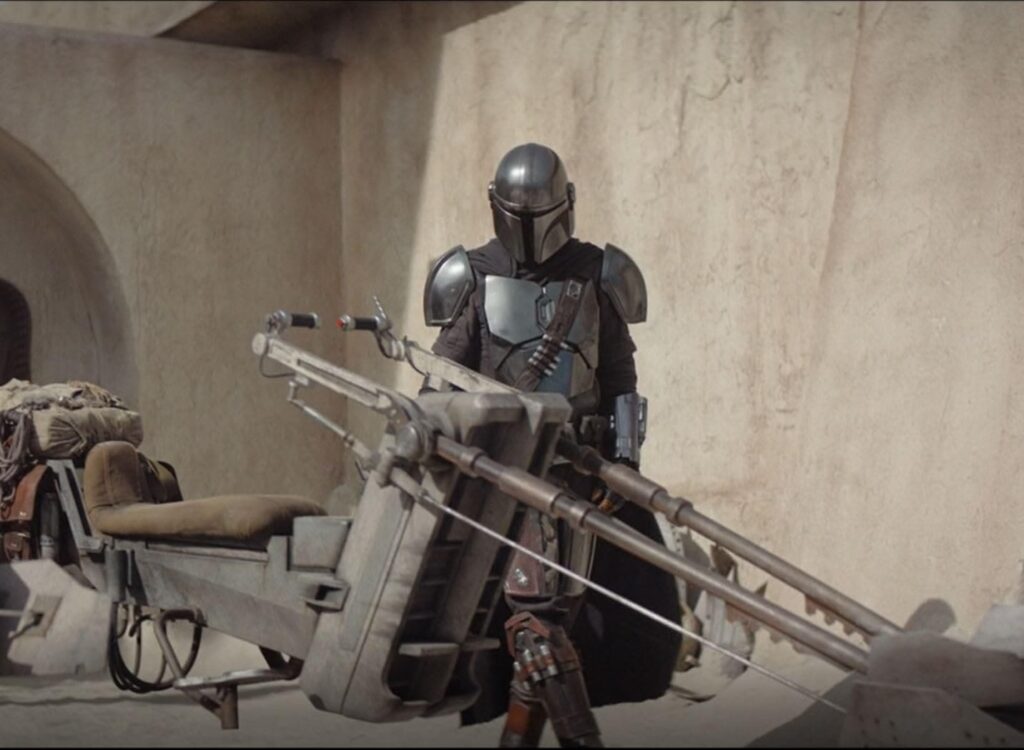
1. Tatooine Revisited: The episode’s return to Tatooine, an iconic planet in the “Star Wars” universe, appeals to fans’ nostalgia and familiarity with this legendary location. Tatooine is rich in history and holds sentimental value for fans.
2. Mos Eisley Spaceport: The episode features the Mos Eisley spaceport, known for its cantina and associations with smugglers and bounty hunters. Its appearance is a direct callback to “A New Hope” and adds a layer of fan excitement.
3. Pit Droids: The inclusion of pit droids, first seen in “The Phantom Menace,” adds a sense of continuity and nostalgia for fans of the prequel trilogy.
Easter Eggs:
1. Droid Repair: The pit droids repairing the Razor Crest pay homage to the podracing sequence in “The Phantom Menace,” where similar droids service podracer engines.
2. Mos Eisley Cantina: The Mos Eisley cantina, famous for its eclectic clientele, makes a return in this episode. While not a central focus, its presence is a nod to its status as a key location in “A New Hope.”
3. Peli Motto: The character Peli Motto, who tends to the Mandalorian’s ship, references R5-D4, the astromech droid with a faulty motivator from “A New Hope.” Peli mentions “R5 unit with a bad motivator.”
4. Boba Fett’s Legacy: The mention of Fennec Shand’s high bounty and her reputation as being on par with Boba Fett adds an exciting layer for fans familiar with the famed bounty hunter’s legacy.
5. Hangar 3-5: Toro’s ship is parked in hangar number 3-5 on Tatooine. This could be a subtle nod to May 35th, which is often jokingly referred to as “Star Wars Day.”
6. Bounty Guild Symbol: The emblem of the Bounty Hunter’s Guild is displayed, resembling the Mythosaur skull emblem seen in various “Star Wars” materials, further grounding the episode in the franchise’s lore.
7. Mos Eisley Docks: The layout of the docking bays and mechanics’ workshops in Mos Eisley provides a fresh look at this location, showcasing its practical and industrial side.
Cultural Impact:
1. Nostalgia: The episode’s Easter eggs and references cater to fans’ nostalgia and love for the “Star Wars” universe, creating a sense of connectivity between different eras of the franchise.
2. Continuity: The inclusion of these elements strengthens the continuity of the series within the larger “Star Wars” narrative, fostering a sense of immersion and interconnectedness.
In summary, episode 5 of “The Mandalorian” provides significant fan appeal through its return to Tatooine, the inclusion of Easter eggs that reference iconic “Star Wars” elements, and its nods to the franchise’s history. These elements contribute to the cultural impact of the series, delighting fans and creating a sense of unity among enthusiasts of the galaxy far, far away.
Enjoyment and potential recommendation:
Enjoyment Factors:
1. Nostalgia: The return to Tatooine and iconic locations like Mos Eisley appeals to fans’ nostalgia for the original trilogy. These settings evoke fond memories while adding new layers to the world.
2. Action Sequences: The episode’s action sequences, particularly the desert showdown, provide moments of excitement and intensity. The strategic tactics employed by the Mandalorian showcase his resourcefulness as a bounty hunter.
3. Character Exploration: The episode continues to develop the Mandalorian’s character, highlighting his cautious nature, resourcefulness, and growing bond with Baby Yoda. Toro Calican’s arc adds complexity to the bounty hunter profession.
4. Genre Fusion: The Western-inspired aesthetic of “The Mandalorian” adds a fresh perspective to the “Star Wars” universe. The genre fusion creates a unique visual and narrative style that sets the series apart.
5. World-Building: The episode expands the universe’s lore by introducing new elements to Tatooine’s environment, such as pit droids and the Mos Eisley docking bays. This world-building adds depth to the setting.
Recommendation:
1. For Fans of the Franchise: Fans of “Star Wars” will appreciate the episode’s references to established lore, Easter eggs, and callbacks to iconic moments. The familiarity with Tatooine and characters like Mos Eisley appeals to their affection for the saga.
2. Genre Enthusiasts: Viewers who enjoy genre-blending storytelling, especially those who appreciate Western aesthetics, will find “The Mandalorian” episode 5 to be a refreshing take on the “Star Wars” universe.
3. Character-Driven Storytelling: Those who appreciate character-driven narratives will enjoy the exploration of the Mandalorian’s evolving relationship with Baby Yoda and the complexities of bounty hunting through characters like Toro Calican.
4. Action and Adventure: Audiences seeking action-packed sequences and suspenseful stand-offs will find the desert showdown and space chase to be engaging and thrilling.
5. Continuity and World Expansion: Viewers interested in a series that expands upon the established “Star Wars” lore, while also introducing new elements and locations, will appreciate how the episode enriches the galaxy’s narrative.
6. Exploration of Morality: Those intrigued by moral complexities and gray areas in characters’ motivations will find Toro Calican’s arc and the exploration of bounty hunting’s ethical dilemmas to be thought-provoking.
In summary, “Chapter 5: The Gunslinger” of “The Mandalorian” offers an enjoyable viewing experience through its blend of action, character dynamics, and nods to “Star Wars” lore.
FAQs
Who is Toro Calican?
Toro Calican is a young and ambitious bounty hunter who seeks to earn his place in the Bounty Hunter’s Guild. He partners with the Mandalorian to capture Fennec Shand.
Who is Fennec Shand?
Fennec Shand is a skilled and notorious assassin with a high bounty on her head. She becomes the Mandalorian and Toro Calican’s target in the episode
How does the episode explore the theme of morality in bounty hunting?
The episode delves into the moral complexities of the bounty hunting profession through Toro Calican’s actions and motivations.
What is the significance of Toro’s fate at the end of the episode?
Toro’s fate serves as a reminder of the dangers and moral challenges that come with being a bounty hunter in the “Star Wars” universe.
What is the premise of “Chapter 5: The Gunslinger”?
In this episode, the Mandalorian returns to Tatooine for repairs and teams up with a young bounty hunter named Toro Calican to capture a high-value target.
